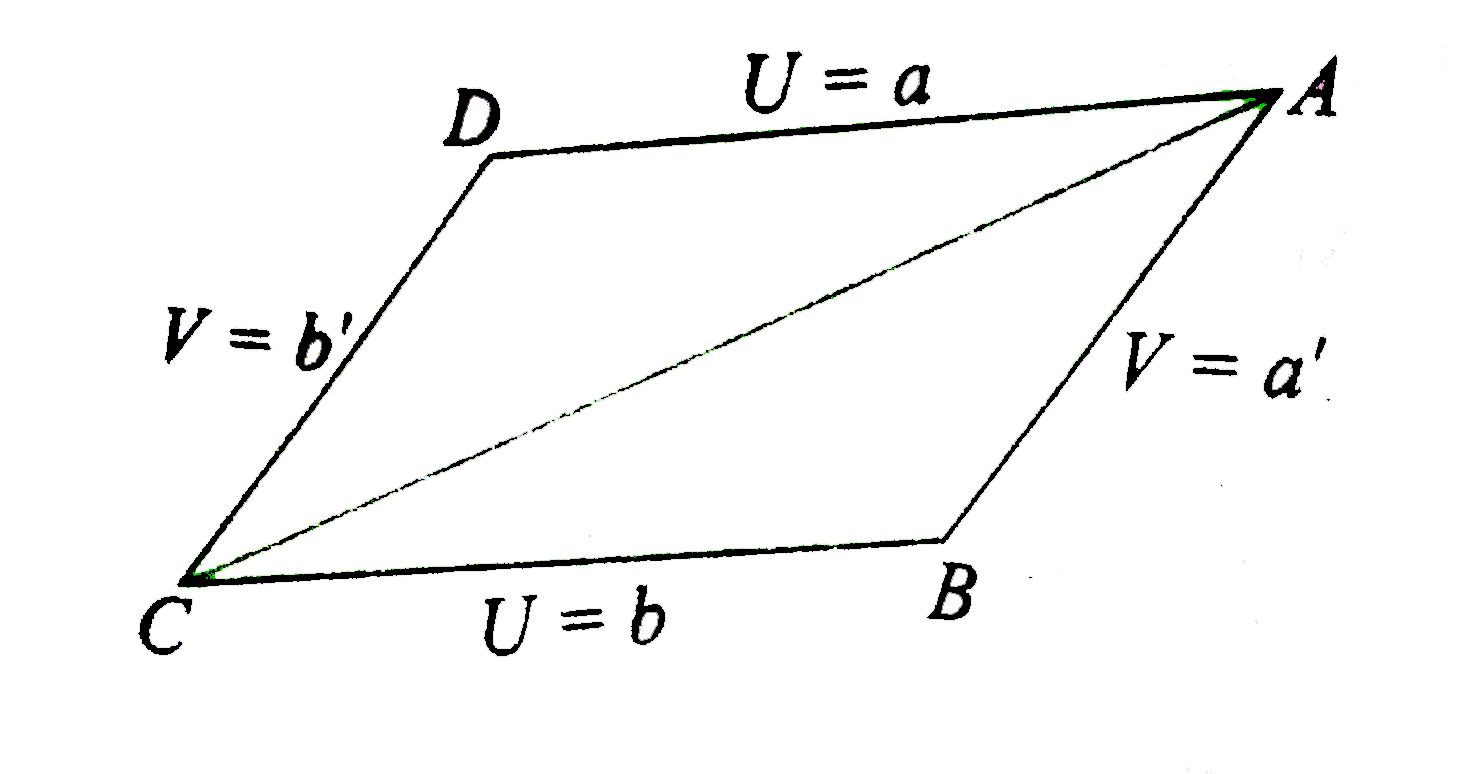Let the sides of a parallelogram be U=a, U=b,V=a' and V=b', where U=lx+my+n, V=l'x+m'y+n'. Show that the equation of the diagonal through the point of intersection of
U=a,V=a'andU=b,V=b' is given by ∣∣
∣∣UV1aa'1bb'1∣∣
∣∣=0.
Solution in Tamil
Parallelogram is formed by lines U=a, U=b, V=a' and V=b', where U=lx+my+n, V=l'x+m'y+n'

Let the required diagonal be AC.
Since one end A of the diagonal AC passes through the point of intersection of lines U-a=0 and V-a'=0, its equation is given by
(U−a)+λ(V−a')=0 (1)
But the other end C of the same diagonal passes through the point of intersection of lines U-b=0 and V-b' = 0.
So, its equation is given by
(U−b)+μ(V−b')=0 (2)
Equation (1) and (2) represents the same straight lines.
∴1=λμ=a+λa'b+μb'
⇒λ=μ=−(a−ba'−b')
Putting the value of λ in (1), we get
(U−a)−(a−ba'−b')(V−a')=0
or ∣∣
∣∣UV1aa'1bb'1∣∣
∣∣=0
This is the required equation of diagonal.
Topper's Solved these Questions
- STRAIGHT LINESBOOK - CENGAGECHAPTER - STRAIGHT LINESEXERCISE - Exercise 2.1
23 Videos
- STRAIGHT LINESBOOK - CENGAGECHAPTER - STRAIGHT LINESEXERCISE - Exercise 2.2
4 Videos
- STRAIGHT LINEBOOK - CENGAGECHAPTER - STRAIGHT LINEEXERCISE - Multiple Correct Answers Type
8 Videos
- THEORY OF EQUATIONSBOOK - CENGAGECHAPTER - THEORY OF EQUATIONSEXERCISE - JEE Advanced Previous Year
9 Videos
Similar Questions
Find the equation of the right bisector of the line segment joining the points (3,4) and (−1,2).
View SolutionFind the points on the line x + y = 1 that lie at a distance 3 units from the line 5x+12y = 3.
View SolutionThe point P(α,α+1) will lie inside the triangle whose vertices are A(0,3),B(−2,0) and C(6,1) if
View SolutionQ. Let p and q real number such that p≠0,p2≠q and p2≠−q. if α and β are non-zero complex number satisfying α+β=−p and α3+β3=q, then a quadratic equation having αβ and βα as its roots is
View SolutionLet V={a,e,i,o,u}and B={a,i,k,u}. Find V−B and B−V
View SolutionLet u≡ax+by+ab3=0,v≡bx−ay+ba3=0,a,b∈R, be two straight lines. The equations of the bisectors of the angle formed by k1u−k2v=0 and k1u+k2v=0 , for nonzero and real k1 and k2 are u=0 (b) k2u+k1v=0 k2u−k1v=0 (d) v=0
View SolutionLet the sides of a parallelogram be U=a, U=b,V=a' and V=b', where U=lx+my+n, V=l'x+m'y+n'. Show that the equation of the diagonal through the point of intersection of
U=a,V=a'andU=b,V=b' is given by ∣∣ ∣∣UV1aa'1bb'1∣∣ ∣∣=0.
View Solutionu = a - b, v = a + b, |a| = |b| = ⇒|u×v| =
View SolutionLet V={a,e,i,o,u}andB={a,i,k,u}. Find V–BandB–V
View SolutionLet V={a,e,i,o,u}andB={a,i,k,u}. Find V–BandB–V
View SolutionLet V={a,e,i,o,u}andB={a,i,k,u}. Find V–BandB–V
View SolutionLet V={a,e,i,o,u}andB={a,i,k,u}. Find V–BandB–V
View SolutionLet V={a,e,i,o,u}andB={a,i,k,u}. Find V–BandB–V
View SolutionLet V={a,e,i,o,u}and B={a,i,k,u}. Find V−BandB−V
View SolutionLet the sides of a parallelogram be U=a,U=b,V=a' andV=b', where U=lx+my+n,V=l'x+m'y+n'. Show that the equation of the diagonal through the point of intersection of U=a,V=a' and U=b,V=b' is given by det ⎡⎢⎣UabVa'b'111⎤⎥⎦=0.
View Solution
